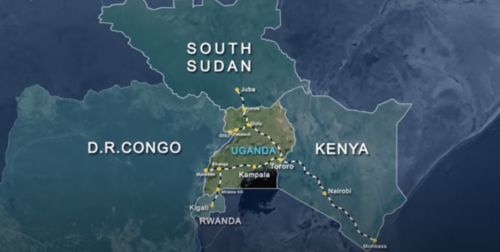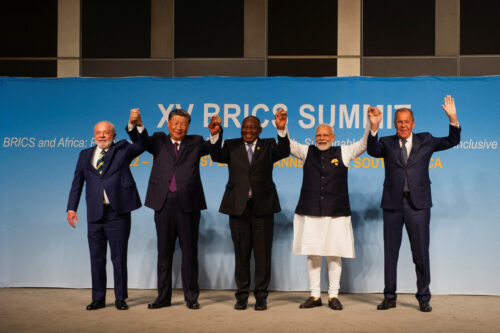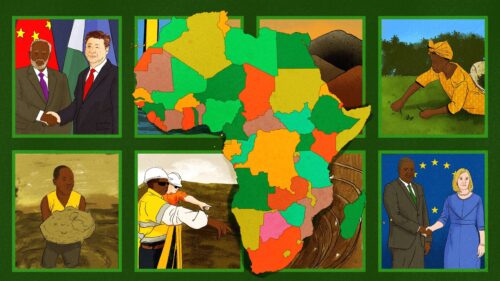Uganda scraps key railway contract with China
Two years of stalled talks and months of silence from China have led Uganda to terminate a $2.3 billion railway contract, as Beijing changes its overseas financing model to avoid billions in debt defaults.

After eight years of financing delays, Uganda has terminated its contract with China Harbour Engineering Company (CHEC) to build the country’s first phase of standard gauge railway (SGR). The East African country has tapped a Turkish firm as the new financier of its part of a region-wide network of railways.
The Uganda SGR is an important railway project that was initially inked between CHEC and the government of Uganda in 2015 to help boost the country’s global competitiveness.
Access to the sea for landlocked Uganda
The $2.3 billion plan was to modernize the country’s outdated meter-gauge railway system, a relic of the British colonial era, to a standard-gauge system used in high-speed rail networks around the globe.
The 273-kilometer (170-mile) line from the Ugandan capital of Kampala to the Kenyan border town of Malaba is a part of the East African Railway Master Plan to link Uganda with the neighboring countries of Kenya, Rwanda, Democratic Republic of the Congo (DR Congo), and South Sudan. The SGR falls under the Northern Corridor Integration Projects (NCIP) transport route, which is crucial for the domestic, regional, and international trade of five Eastern African countries. It connects Burundi, Eastern DR Congo, Kenya, Rwanda, South Sudan, and Uganda.

Image via YouTube video on Uganda SGR website
The Central Corridor, the other major transport route, links Burundi, Rwanda, Uganda, the eastern part of the DR Congo, and all of central and northwestern Tanzania.
“Lack of affordable transport to the sea has limited Uganda’s exports to neighboring countries like Kenya, South Sudan, and Rwanda, where there is connectivity by road,” says Uganda’s justification statement. Mombasa being “the busiest port on the Indian Ocean coast and its proximity to the main maritime shipping routes through Bab el Mandala, the Suez Canal makes the SGR project most viable” for the region, per the statement.
Two years of failed negotiations
But negotiations with Beijing to fund Uganda’s segment of SGR have stalled for nearly two years, pushing Uganda to drop the deal. Chinese financiers reportedly got cold feet due to concerns that the project might not be viable if it wasn’t joined up to Kenya’s portion of the railway at the same time — a crucial link that connects Uganda’s segment to the lucrative maritime trade routes on the Indian Ocean.
Perez Wamburu, Uganda’s project coordinator, said that Uganda’s Attorney General Kiryowa Kiwanuka was prompted to review the contract with CHEC after it became apparent that Chinese state-owned Exim Bank — the main financier of Kampala’s infrastructure projects over the last decade — no longer wanted to bankroll the SGR.
Neighboring Kenya has already built its 730-kilometer railroad segment between the Mombasa port city to Naivasha with Chinese loans, but hasn’t determined when it might develop the link to Uganda. Last October, Beijing fined Kenya $10.8 million for loan defaults on its SGR, since the revenues generated from the passenger and cargo services on the track were not enough to meet its operation costs.
Changing Chinese financing model
“The Chinese financing model started changing for the East African region in late 2018, when countries showed signs of repayment issues. At that time, Ethiopia — which had been a big beneficiary of Beijing’s loans to modernize its railways and its Special Economic Zones (SEZs) — asked for a repayment extension,” Allan Olingo, news editor for Kenya’s Nation Media Group, told The China Project.
“This was followed by other countries. The COVID pandemic worsened these scenarios, and for the first time, we saw a rise in requests by African countries seeking either debt readjustments, or forgiveness from Beijing,” he added. “We have since seen the East African region either turning to syndicated loans, or public-private partnerships projects to continue with infrastructure modernization moves, as Beijing went slow on financing.”
Uganda has instead tapped Turkish construction firm Yapi Merkezi to take on the role as financier for its SGR. The two sides have signed a memorandum of understanding (MoU), but a final agreement has not been signed yet.
The decision may help Uganda consider an alternative route through its southern neighbor Tanzania, where Yapi Merkezi is already building new railroads. However, Tanzania has also inked a $2.2 billion agreement with two Chinese companies, China Civil Engineering Construction Corporation and China Railway Construction Corporation Limited, to construct the second phase of its 506-kilometer (314-mile) standard SGR.
“This now means that the region will pursue an individualized plan to modernize its railways, as opposed to the joint East African Railway Master Plan,” Olingo told The China Project. “The plan’s ending point started in 2015, when the late Tanzanian President John Magufuli shelved the $10 billion contract that China had won to construct the Tanzanian SEZ. He later awarded this contract to the Turkish firm Yapi Merkezi.
“This is now the same form that Uganda has turned to after China raised viability concerns with Kenya’s plan to extend the railway from its Nairobi capital to the Uganda border town of Malaba. It became clear that the region’s Railway Master Plan could not be achieved jointly and thus, each country is now seeking to try to complete their sections independently,” he added.
The scrapped deal comes as Beijing grows more cautious about the terms of its overseas financing on Belt and Road initiatives, as it retools its approach to favor smaller, less-risky loans.
“We read between the lines when China’s ambassador to Uganda said that after the COVID-19 pandemic, China has become more cautious about financing big infrastructure projects in Africa,” Wamburu said. “We all know that COVID didn’t leave the economies of the world the same.”
“Practical cooperation between [China and Uganda] is a pacesetter for China-Africa cooperation,” Chinese Foreign Ministry spokesperson Wāng Wénbīn 汪文斌 said when asked about the deal’s termination at a regular news briefing on January 13. “Going forward, China stands ready to work with the international community to continue to carry out infrastructure, investment, and financing cooperation with African countries and remove the major bottlenecks hindering Africa’s independent development.”
“Chinese infrastructure development financing has indeed fallen precipitously in recent years, but I see this as more an evolution of BRI financing than a pullback,” said Eric Olander, editor-in-chief of The China-Global South Project.
“The Chinese have shifted their priorities away from larger, more costly infrastructure projects to smaller initiatives focused largely on energy, telecommunications, and logistics. These projects tend to be in the tens of millions, sometimes hundreds of millions of dollars, rather than billions of dollars,” Olander , told The China Project. “Take for example the $249 million China Exim Bank loan to Angola to build out the country’s broadband infrastructure as a great example of the kinds of projects Chinese policy banks are backing.
“This isn’t only a Chinese issue. Borrowing countries in Africa and the Americas have also conveyed to the Chinese that they are not in a position to take on billions more in debt, so this change from larger to smaller projects is really more of a mutual decision than a unilateral call from Beijing,” he added. “But this isn’t true everywhere around the world. While the Chinese have become more conservative in Africa and South America, for example, that is not the case for Southeast Asia and Central Asia, where the Chinese are still keen to build large connectivity projects like railways, dry ports, and seaports.”






